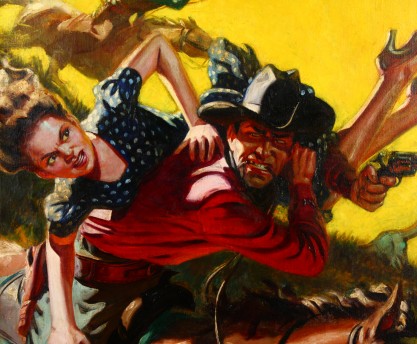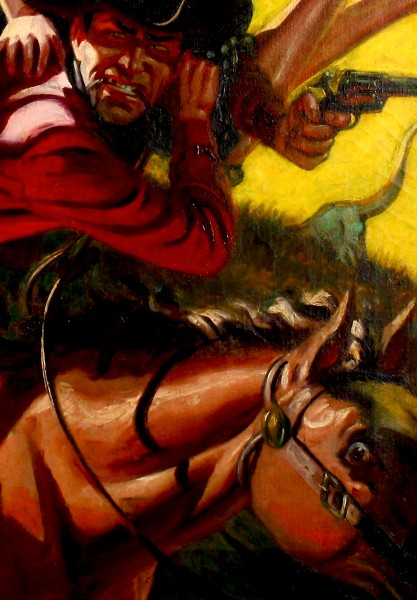

 |
| Above: The artwork as it appeared on Speed Western Stories – April 1943 |
Allen Anderson created this damsel in distress, spicy pulp oil on canvas painting as the cover for the April 1943 edition of Speed Western Stories, Volume #1 issue #4 (Trojan Publishing, Chicago). This vivid and rare surviving example of lurid spicy pulp cover art was unearthed by Grapefruit Moon Gallery along with two additional original cover paintings by Allen Anderson that had for many years been displayed at the Cimarron Dude Ranch in Peekskill, New York. The dude ranch was known from the 1950s through the 1970s as an anything goes destination that catered to the rustic yet scandalous moods of New York City bohemians and artists. Anderson, who moved to the region in 1954, became friendly with the staff of Cimarron, and these were gifted by the artist to hang in the the ranch’s boisterous tavern confines. After Cimarron closed, the paintings were kept in the collection of one of the ranch’s managers until 2013. They have never been on the market prior to this offering. The image loosely illustrates the story “Bucky Swings the Whip” by Lawrence Donovan (Kenneth Robeson) though, as was often true with pulp covers, this image was created by Anderson before the contents of the magazine had been determined.

Though this painting includes all the essential peril and excitement associated with spicy pulp cover art, it also plays with the genre of the Spicy Western by placing at its center a heroine who judging by her stylish modern dress seems more at home in the secretarial pool than on the range. Mixing a modern dressed every-woman into this Old West cowboy scene makes the menace of the image all the more unnerving. The Spicy Western was a short lived pop culture phenomenon that used the lawless setting of the Old West as a way to hide in plain sight the subversive and often hyper-sexual content and imagery of the Spicys. The lurid, terrifying and often times violent Western Americana imagery played upon the darker impulses of readers, often tapping into sexual fantasy and fetish. The focus and talent of Anderson can be seen readily in this canvas where he puts his effort in capturing detail within the dynamic elements at play. The villain, pin up, and even horse are all captured with tremendous depth, while the hero with lasso in the distance is purposefully captured with less detail to leave the outcome in suspense. This oil painting is in a very fine state of conservation and is one of the rare examples of the artist’s published pulp covers to emerge.
 |
| Above: Verso view of original pine stretchers and old original canvas |
 |
| Above: Detail of back stretcher bars |
Allen Anderson was born in Minneapolis, Minnesota in 1908. After taking two years of correspondence art courses, he took a job working for Fawcett Publications. In 1939, he moved to New York City to join his life-long friend and fellow illustrator Norman Saunders, working in a tight knit circle who called themselves the Bad Boys Group. Shortly after his move, however, it became clear that Anderson, along with many pulp illustrators, would be called up to service in World War II. Rather than lose the momentum he had begun building as an in-demand artist during the war, Anderson spent the next six months painting as many covers as he could, so that he could sell them throughout the war. This is one of the 57 pieces he created for titles such as Spicy Stories, Speed Western Stories, Spicy Western Stories, Spicy Mystery, Spicy Stories, Spicy Detective, and Super Detective during that period. A Navy man, Anderson spent the war teaching graphic design and lettering at a naval training camp in upstate New York–it is during this time he likely first visited the Cimarron Dude Ranch. After the war, he returned to work as a pulp artist for nearly a decade, retiring in 1954 when he left New York City permanently to return upstate with his new bride, Joan. Anderson died in 1995.
